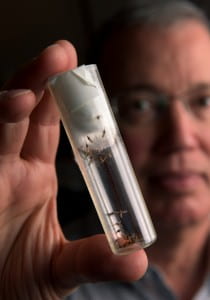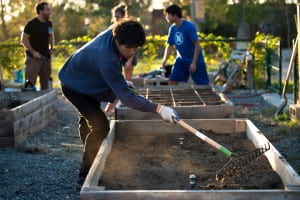UCI takes a leap into the future with release of ambitious strategic plan
10-year vision includes growth in research, community impact, enrollment and faculty

Irvine, Calif., Feb. 29, 2016 – University of California, Irvine leaped into a new era with the release today of an aggressive strategic plan for the future that secures its place among elite research institutions.
A 10-year forecast developed with extensive participation from the university community, UCI’s new road map creates a path to unprecedented heights of distinction and social impact. Building on existing strengths, it aims to make UCI even better by honoring the founders’ spirit of innovation and excellence.
“In order for UCI to continue to thrive, we have to be willing to take our future into our own hands – develop new partnerships, invest in research that matters, serve our community in meaningful ways, and provide the best educational environment for each and every Anteater,” UCI Chancellor Howard Gillman said.
The plan is based upon four pillars:
- Growth that makes a difference: Expanding our capacity to improve lives
- First in class: Elevating the student experience to prepare future leaders
- Great partners: Making regional and global connections that enhance our mission and serve the people
- New paths for our brilliant future: Forging best practices to power the coming century

Steve Zylius / UCI
“With this plan, we have a clear direction into the foreseeable future that echoes the promise of our university’s founding mission,” said Enrique Lavernia, UCI provost and executive vice chancellor. “We will mobilize knowledge, we will serve the people, and we will educate the best and brightest.”
The plan sets out a new way of thinking about university funding in a changing higher education landscape. State resources will be used to ensure access for qualified students. New programs, infrastructure and research funding will come from community and donor partnerships and successful grant proposals to government and private foundations and funding agencies.
“We must make sure that all of our leaders – every dean, every vice chancellor and the heads of each of our programs – agree that we’re going to spend most of our time on external relations and relationship building and fundraising,” Gillman said. “We can no longer look inward for our funding. Those days are over.”
“We are well-positioned to demonstrate that, with innovative thinking and an inspiring message, we can thrive in the current environment. We have a tremendously talented and idealistic community, making extraordinary contributions to knowledge, education, social mobility, and human well-being. Our original mission remains vital, and we are excited to deepen our relationships with our surrounding community, our wonderful alumni, our supporters, and all people of good will who realize that, by acting together on our shared values and interests, we can transform lives and improve society.”
Among the specifics in the plan:
- Expand UCI’s research and teaching capacity by adding 250 faculty members over the next five years.
- Increase research expenditures to more than $500 million annually (from about $300 million today).
- Grow student enrollment from 31,000 today to around 40,000 in 10 years, but not all of those new students will live on campus.
- Allow students to design majors that may have nothing to do with formal schools or departments.
- Enroll at least 25 percent Hispanic students.
- Create a better graduate-to-undergraduate student ratio – about 25 percent to 75 percent.
- Expand our community partnerships and research in water conservation, clean energy and sustainable lifestyles to develop a national model of how to live responsibly and well in the 21st century.

Steve Zylius / UCI
“The progress we make as an institution depends on talking to people who share our vision and want to have a real impact on the world,” Lavernia said. “It’s our job to convince them that UCI is the right place to make that happen.”
About the University of California, Irvine: Currently celebrating its 50th anniversary, UCI is the youngest member of the prestigious Association of American Universities. The campus has produced three Nobel laureates and is known for its academic achievement, premier research, innovation and anteater mascot. Led by Chancellor Howard Gillman, UCI has more than 30,000 students and offers 192 degree programs. It’s located in one of the world’s safest and most economically vibrant communities and is Orange County’s second-largest employer, contributing $4.8 billion annually to the local economy. For more on UCI, visit www.uci.edu.
Media access: Radio programs/stations may, for a fee, use an on-campus ISDN line to interview UC Irvine faculty and experts, subject to availability and university approval. For more UC Irvine news, visit wp.communications.uci.edu. Additional resources for journalists may be found at communications.uci.edu/for-journalists.